Stained Glass Windows
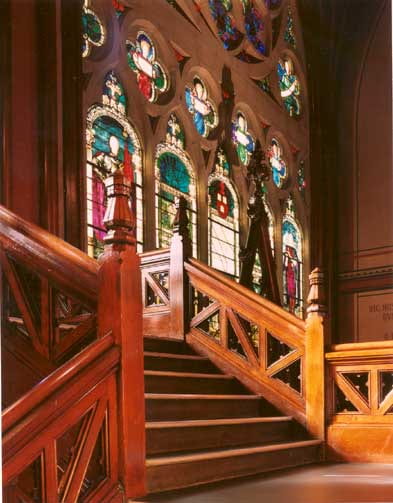
Overview
Because they represent such a variety of designers, manufacturers and techniques, the collection of stained glass in Memorial Hall comprises a veritable museum of American stained glass. Artistic styles range from the traditional European techniques employed by the British designers of the earlier windows to the innovative use of new glass forms which are hallmarks of the American or Opalescent Style first developed by John La Farge and Louis Comfort Tiffany. Installed between 1879 and 1902, the majority of windows were commissioned and funded by various alumni classes. The Harvard Corporation’s original guidelines for the windows required that:
Each window shall contain one or more upright figures, about the size of life, with an ornamental panel or inscription occupying the ventilator panel below, all with a boarder or canopy; and that these figures shall be typical or historical. The choice of design is also restricted to characters prior to the time of Shakespeare, it being the intention that the windows, when all complete, shall unite harmoniously into one great theme.
These guidelines were loosened over time. For example “typical and historical” was expanded to include allegorical figures such as Honor and Peace. The most apparent deviation from the Corporation’s original guidelines is in John La Farge’s Battle Window which depicts a continuous scene rather than one figure per lancet. The Battle Window is a gift of the class of 1860 which lost twelve classmates, including Robert Gould Shaw, to the Civil War. Approximately half of the windows illustrate Civil War-related themes while the others depict cultural, literary and historic subjects.
La Farge executed four windows for Memorial Hall. Other highlights include two windows by Sarah Wyman Whitman and three windows executed by Tiffany Studios. The one unfinished window on the south wall of Annenberg Hall will be completed in memory of Roger Annenberg, ’62.
All Materials taken from The Stained Glass Windows in Memorial Hall, Harvard University by Mason Hammond. Cambridge, Mass: (The author), 1978.
Photo credit: Steve Rosenthal
Annenberg Hall
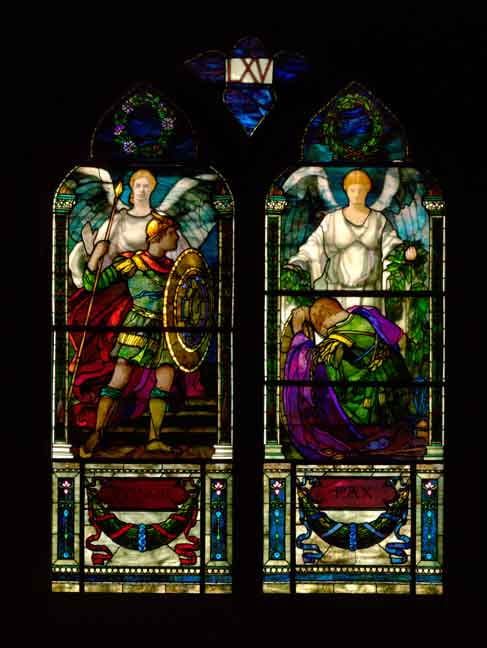
Honor and Peace
Artist: Sarah Wyman Whitman Manufacturer: Sarah Wyman Whitman
Date: 1900
Type: American opalescent
Funded by: Class of 1865
This window commemorates those; who surrendered their lives in the War of the Rebellion,” this window shows left, “Honor” sending forth an armed warrior to battle. On the right is “Peace” welcoming him in Ãhis civilian clothes with a wreath. There is no commemorative inscription; however, the two halves most likely refer to the members of the class who went to war (honor) and then returned home (peace).
Photographed by: Stephen Sylvester and Yosi A.R-Pozeilov
Digital Imaging and Photography Group Harvard College Libraries
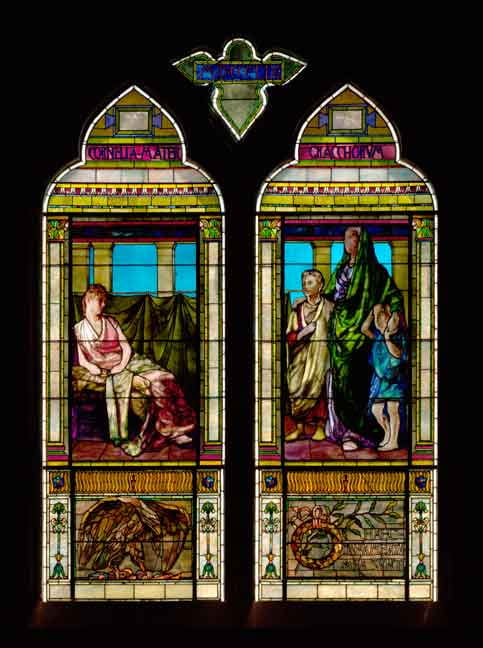
Cornelia, Mother of the Gracchi
Artist: John La Farge
Manufacturer: John La Farge
Date: 1891
Type: American opalescent
Funded by: Class of 1859
This window depicts a Campanian woman holding a bracelet or necklace on the left, while Cornelia stands in front of her holding her two sons on the right. All three figures are draped in colorful cloths. How this window reflects upon the eight individuals who died in this class is somewhat difficult to make out. However, Valerius Maximus, the author of this tale may help. In his Nine Books of Memorable Deeds and Sayings, he tells that when a rich Campanian woman boastfully displayed her jewels to Cornelia, the latter, in reply, presented her two sons with the remark: “These, said she, are my ornaments.”
Photographed by: Stephen Sylvester and Yosi A.R-Pozeilov
Digital Imaging and Photography Group Harvard College Libraries
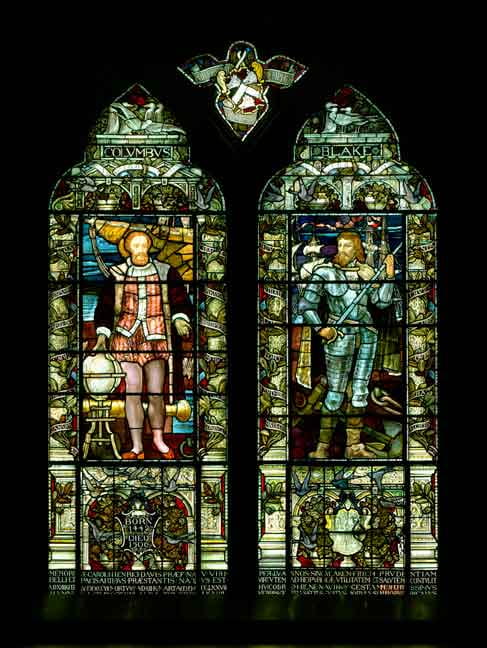
Christopher Columbus and Admiral Robert Blake
Artist: Henry Holiday
Manufacturer: Powell and Sons
Date: 1880
Type: English painted, no plates
Funded by: Family of Rear Admiral Charles Henry Davis
The left half shows Columbus with his hand rested on a globe upheld by a tripodal stand. The right shows Admiral Robert Blake (1599-1657) holding the handle of a sword that reaches up across his body and out past his left shoulder. Understanding that these two individuals have been celebrated for their different explorations, this window appears to be a tribute to the Rear Admiral’s own successes.
Photographed by: Stephen Sylvester and Yosi A.R-Pozeilov
Digital Imaging and Photography Group Harvard College Libraries
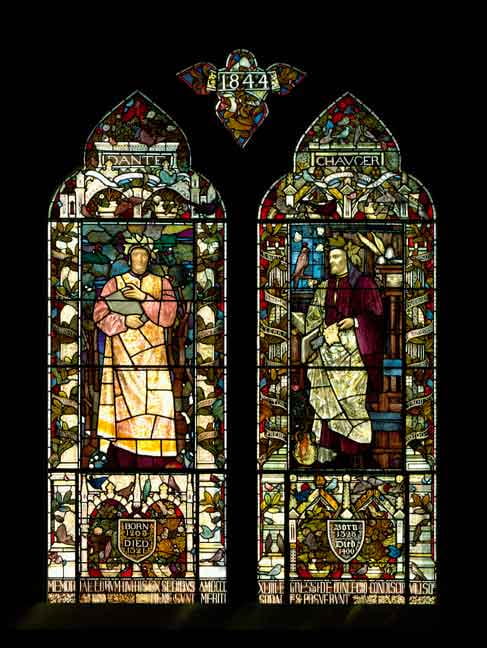
Dante and Chaucer
Artist: Henry Holiday
Manufacturer: Powell and Sons
Date: 1879
Type: English painted, no plates
Funded by: Class of 1844
This window pictures Dante (left half) in a full length light colored robe. With a wreath on his head he stands to the front holding a book against his right breast. On either side of him are columns with ribbons bearing names of characters, which are essentially illegible, from the Divina Comedia. On the right is Chaucer standing toward Dante with a paper in his left hand before his stomach and a book in his right hand, against his side. On either side of him are ribbons wrapped around columns bearing names from the Canterbury Tales. The meaning of this window for the Civil War dead is difficult to tell.
Photographed by: Stephen Sylvester and Yosi A.R-Pozeilov
Digital Imaging and Photography Group Harvard College Libraries
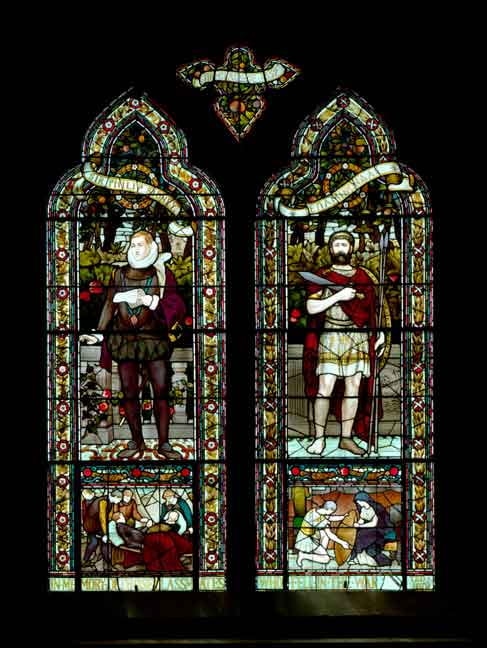
Sidney and Epaminondas
Artist: Daniel Cottier
Manufacturer: Daniel Cottier
Date: 1879
Type: English painted, no plates
Funded by: Class of 1857
This window shows the Elizabethan poet Sir Philip Sidney wearing a costume of black doublet and britches and hose with a high white ruff at his neck and a dark red cloak off his shoulders. At his left side hangs a sword crossing down behind his legs. In his left hand he holds a sheet of paper on which five lines are written in small Latin capital letters. They read MY TRUE LOVE HATH/ MY HEART AND I HAVE HIS/ BY JUST EXCHANGE ONE TO/ THE OTHER GIVEN/ I HOLD HI . . . . Sidney died from a wound in the Battle of Zutphen. In the right half, stands Epaminondas (418-362 B.C.E.), a well-educated Theban, who with the help of his colleague Pelopidas, defeated Sparta. He stands squarely front wearing a white tunic with a belt at the waist and a heavy red robe clasped on his right shoulder. He holds a short sword in his right hand and in his left hand, down by his side, he holds two spears vertically. Wounded in the Theban victory over Sparta at Mantinea in 362, he died soon after. Considering that both men were scholars and patriotic soldiers who died from wounds received in battle, they are fitting emblems to commemorate the Union dead of the class.
Photographed by: Stephen Sylvester and Yosi A.R-Pozeilov
Digital Imaging and Photography Group Harvard College Libraries
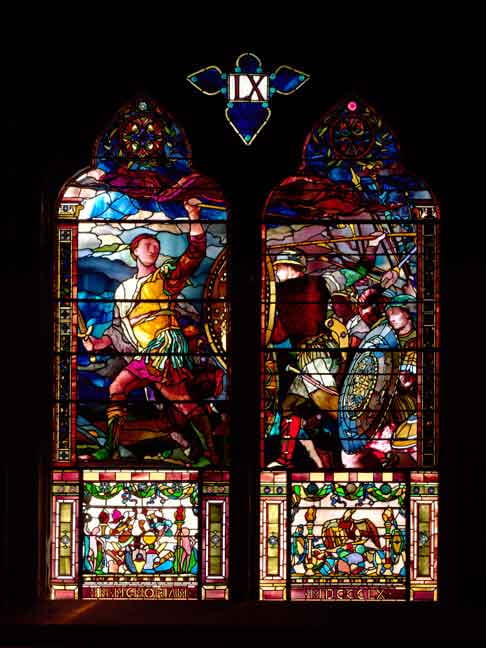
The Battle Window
Artist: John La Farge
Manufacturer: John La Farge
Date: 1881
Type: Plated opalescent
Funded by: Class of 1860
In the left half is a classical warrior, clad in a light colored cuirass, striding toward the viewer’s left with his body and head turned back to encourage his followers. In his right hand he holds a sword and in his left hand he holds the staff of a dark red banner horizontally above his head. Behind the lead warrior is a man carrying a decorated shield. A short sword hangs by his left side while
his right arm is extended backward holding a spear horizontally. Behind this individual is a man bearing a shield, brandishing a sword and wearing a helmet. Underneath the two panels runs a Latin inscription reading “In memory = 1860.”
Photographed by: Stephen Sylvester and Yosi A.R-Pozeilov
Digital Imaging and Photography Group Harvard College Libraries
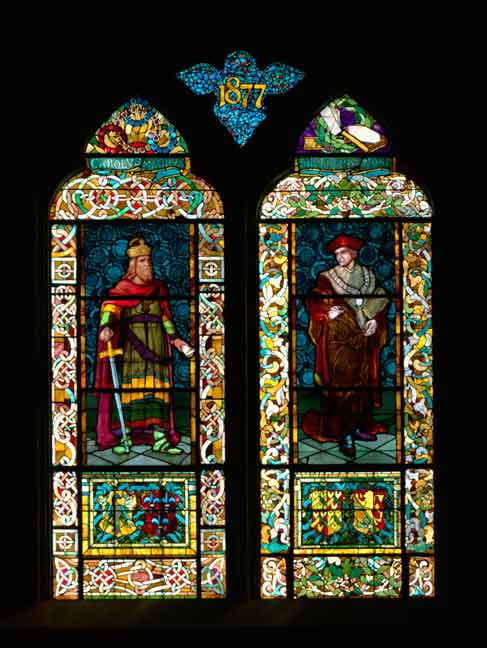
Charlemagne and Sir Thomas More
Artist: Charles Eastman
Manufacturer: McPherson
Date: 1888
Type: Plated and painted opalescent
Funded by: Class of 1877
In the left half is Charlemagne wearing a gold colored shirt or tunic belted at the waist. From the belt a sword baldric crosses from his right elbow to his left thigh. Over his tunic he has a dark red robe which covers his chest and shoulders. His right hand rests on the pommel of a long sword. On the right, Sir Thomas More looks towards Charlemagne, wearing a dark red full gown. His right hand is bent forward at the elbow with the hand open and palm down, in a gesture perhaps of speech. Given by the class of 1877, one of the classes which was in College during the construction of Memorial Hall, this window does not commemorate the Civil War dead but instead depicts themes appropriate to the University. Themes are sovereignty and political wisdom (represented by Charlemagne), learning, service to the state and integrity (More).
Photographed by: Stephen Sylvester and Yosi A.R-Pozeilov
Digital Imaging and Photography Group Harvard College Libraries
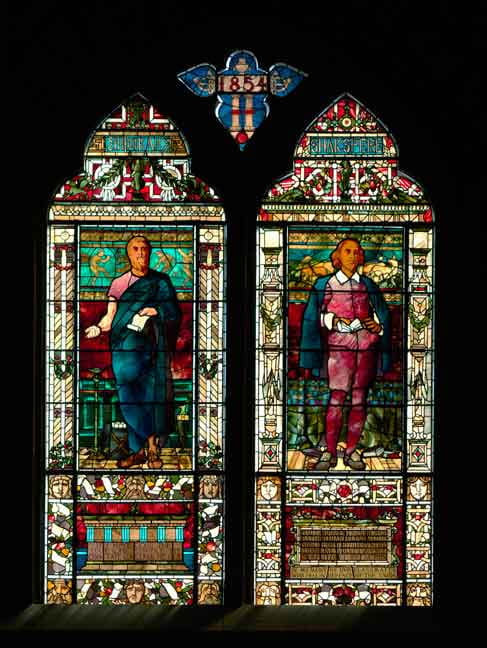
Sophocles and Shakespeare
Artist: Frederic Crowninshield
Manufacturer: McPherson
Date: 1883
Type: Plated opalescent
Funded by: Class of 1854
In the left half of the window stands the Athenian tragic poet Sophocles (495-406 BCE). Wearing a reddish tunic and wrapped in a blue robe he holds in his left hand a partly unrolled scroll. Above Sophocles is a frieze with four dancing youths. Under him is a sarcophagus. In the right half stands the English dramatic poet Shakespeare (1564-1616) looking away from Sophocles. He is wearing a reddish doublet, knee-britches, hose and shoes. In his right hand he holds before his stomach an open book. There is also a frieze above Shakespeare displaying a lying horned stag and a lying doe. The relevancy of this window to the Union dead is unknown.
Photographed by: Stephen Sylvester and Yosi A.R-Pozeilov
Digital Imaging and Photography Group Harvard College Libraries

The West Window
Artist: Donald MacDonald
Manufacturer: McPherson
Date: 1874
Type: Painted grisaille
Like those in the transept this window is of Gothic design. The upper portion of the window contains a large rose with twelve leaves. Its lower curves are flanked by two smaller roses, each with eight leaves. Below are five lancets whose points reach up into the upper portion. Of the three roses at the top, the smaller one on the left displays in a circle the arms of the United States. On the right in a similar circle is the arms of the Commonwealth of Massachusetts. The large central rose has four iron supporting bars which form the wide arms of a cross. In the crossing of the arms is a circle which contains the arms of Harvard, with a slight overlap outside the circle. The arms of the United States show a spread eagle’s head, facing the viewer’s left. His claws rest on, and probably hold, a ribbon with the motto E PLURIBUS UNUM, which means “From many one.” On the blue shield of the arms of the Commonwealth is a Native American holding a bow in his right hand and an arrow in his left. A motto is inscribed on five pieces of ribbon surrounding the shield. The motto is to be read down on the left and up on the right. It reads ENSE PETIT / PLACIDAM / SUB / LIBERTATE / QUIETEM = She (the commonwealth) seeks calm peace under liberty. The Harvard shield in the central circle has three books, two above and one below, separated by a chevron with an ornamental pattern on it. They read VE – RI – TAS = Truth.
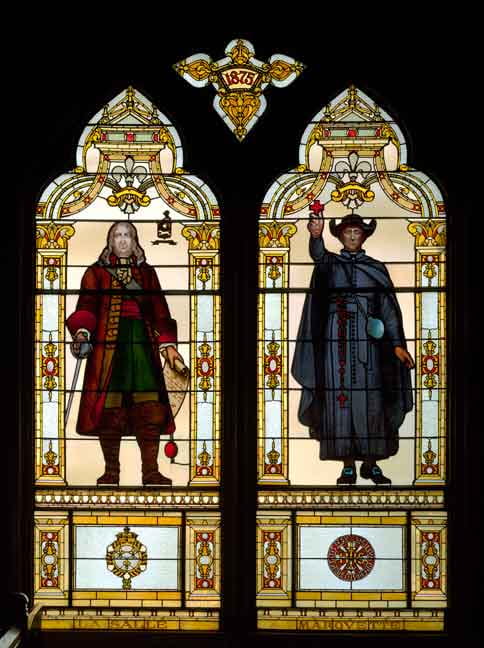
La Salle and Marquette
Artist: Charles Mills
Manufacturer: Ford & Brooks
Date: 1895
Type: Plated opalescent
Funded by: Class of 1875
In the left half Rene Robert Cavelier, Sieur de La Salle (1643-1687), a French explorer, wears a dark red mantle that falls below his knees and has a high collar and cuffs turned back deeply at the wrists. Under it is a black coat to mid-thigh with a red sash and a white scarf or necktie showing at the neck. In his right hand he holds a heavy sabre and in his left he holds a half unrolled scroll with its red seal hanging. In the right half Jacques Marquette (1637-1675, a Jesuit Missionary who was sent to work among the Native Americans of Canada, particularly those around the Great Lakes. In 1673, in company with Louis Joliet, he reached and descended part way down the Mississippi, even before La Salle had explored it to its lower reaches. He is portrayed here as preaching to Native Americans. He wears a black clerical hat and a black clerical cassock nearly to his knees. The cassock has a dark blue sash at the waist with a rosary tucked through it whose cross hangs down to his thigh. His right arm is raised holding a small crucifix.
Photographed by: Stephen Sylvester and Yosi A.R-Pozeilov
Digital Imaging and Photography Group Harvard College Libraries
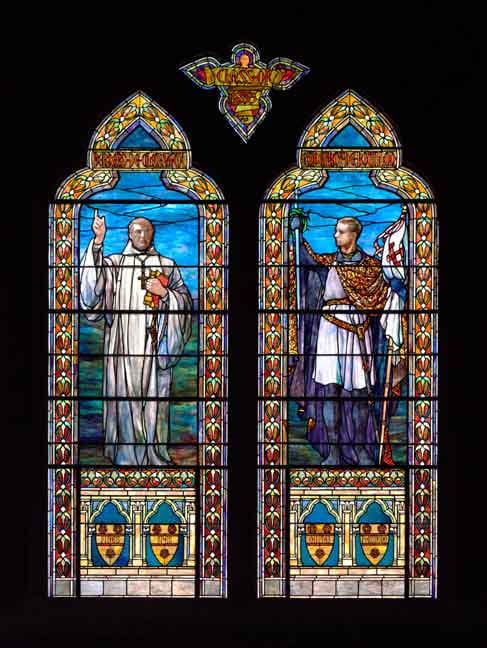
Bernard and Godefroy
Artist: Edward Sperry
Manufacturer: Church Decorating Company
Date: 1902
Type: Plated opalescent
Funded by: Class of 1855
In the left half stands Bernard (1090-1153), a member of the Cistercian order of Benedictines, who founded the reformed and ascetic monastery of Clairvaux. He wears a long white monk’s robe with a cross hanging from his neck. His right arm is raised bestowing a blessing. His left arm holds a large closed book next to the pectoral cross. In the right half Godefroy, a German commander who conquered Jerusalem in 1099 and was then later elected its ruler, wears a white tunic over armor. A patterned red cloak with a purple lining is clasped around his neck. With his right arm grasping a long sword, his left arm is extended holding a white banner which shows above his head in its folds a red crusader’s cross.
Under each figure in the cross-bars is inscribed four different virtues: left, under Bernard, FIDES * SPES = Trust * Hope; and right, under Godefroy, CARITAS * FORTITUDO = Love * Fortitude. Faith, Hope and Charity are the familiar virtues from St. Paul, I Corinthians 13.13, and Fortitude is an apt description of both Bernard and Godefroy.
What is special about this window is that represented in the figures are the faces of contemporary persons. Bernard has the features of Phillips Brooks (1835-1893), class of 1855, who was the rector of Trinity Church in Boston and a very well-known preacher and religious leader. Godefroy has the features of Francis Channing Barlow (1834-1896), class of 1855, who rose from private to Major General during the Civil War and after the war, refusing a permanent commission in the army, devoted himself to politics and law.
Photographed by: Stephen Sylvester and Yosi A.R-Pozeilov
Digital Imaging and Photography Group Harvard College Libraries
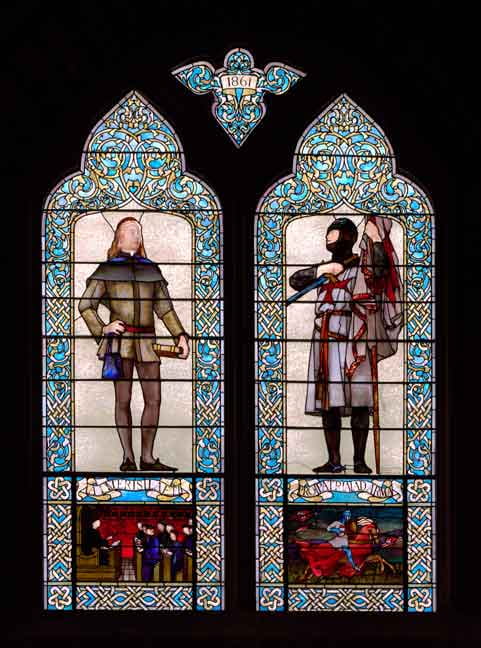
Student and Soldier
Artist: Francis Millet
Manufacturer: Tiffany Studios
Date: 1889
Type: Plated opalescent
Funded by: Class of 1861
In the left half the Student stands wearing a dark embroidered jacket or doublet. He has a short black cape around his shoulders and black hose and slippers. His left arm is stretched down and out from his body holding a book. In the right half the Soldier stands wearing a dark head covering. Under this covering is a black chain mail hood which comes up from his body armor and surrounds his face closely, revealing it only from the eyebrows to just below the mouth. Over his black chain mail body armor is a gray surcoat or tunic with a red cross on the chest. In his left hand he holds the staff of a gray and black banner whose folds he clasps at the level of the top of his head. The symbolic quality of the Soldier or Scholar is to show charity to those in worse case than themselves. (see p. 291) They emphasize the heroism of those who died in the Civil War.
Photographed by: Stephen Sylvester and Yosi A.R-Pozeilov
Digital Imaging and Photography Group Harvard College Libraries
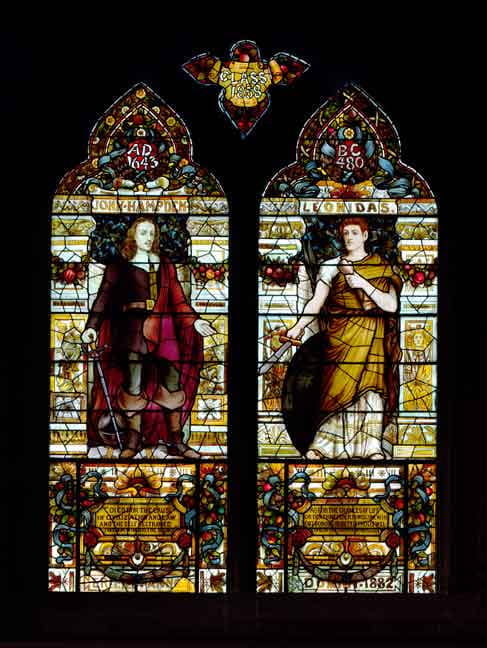
John Hampden and Leonidas
Artist: Daniel Cottier
Manufacturer: Daniel Cottier
Date: 1882
Type: English painted, no plating
Funded by: Class of 1858
In the left half stands John Hampden, a leader in the opposition of Parliament to the arbitrary rule of Charles I in England. He was wounded in the battle of Chalgrove Field against Prince Rupert on June 18, 1643, and died on June 24. He wears a dark coat with a broad white collar. A russet cloak hangs from his left shoulder down his back and left side. In the right half is Leonidas, a Spartan King who commanded the Greek forces sent to hold the pass of Thermopylae in 480 BC against the advance of the Persian host under their king Xerxes. He was destroyed by the Persians when they outflanked his position. He is wearing a white tunic with a full yellow-brown cloak passing over his left shoulder and under his right arm. The meaning of this window is similar to Window #5, Sydney and Epaminondas. The death of both men (Hampden and Leonidas) in battle commemorates the valor and patriotism of the individuals from Harvard who died in the Civil War.
Photographed by: Stephen Sylvester and Yosi A.R-Pozeilov
Digital Imaging and Photography Group Harvard College Libraries
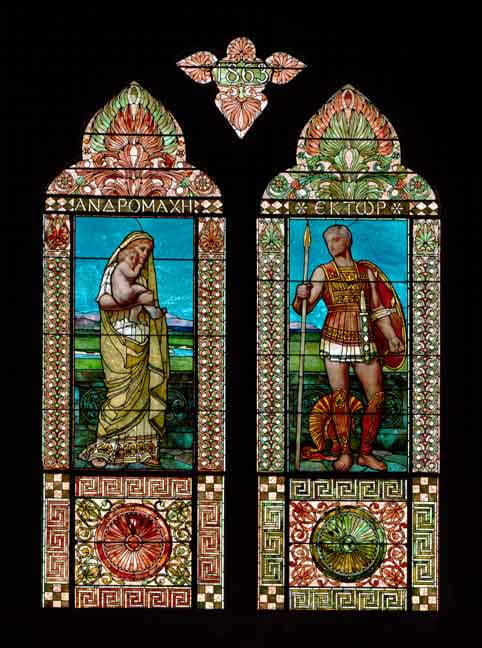
Parting of Hector and Andromache
Artist: Frederic Crowninshield
Manufacturer: Frederic Crowninshield
Date: 1888
Type: Plated opalescent
Funded by: Class of 1863
This scene takes place outside the Scaen Gates, leading down to the plain of Troy, which forms the background for the figures. Through the plain flows the Scamander River and on the horizon is a glimpse of the blue Aegean Sea, with the mountains of Samothrace and Imbros in the distance. In the right half stands Hector, wearing a copper colored and ornamented breastplate over a white tunic. He is youthful and beardless to symbolize the college boys and their subsequent fate. On his left arm he bears a copper colored shield . In his right hand he grasps an upright spear. Over his right shoulder is a short sword in its scabbard. In the left half stands Andromache holding the child Astyanax. She wears a long white tunic with a green robe over her head and upper back.
Photographed by: Stephen Sylvester and Yosi A.R-Pozeilov
Digital Imaging and Photography Group Harvard College Libraries
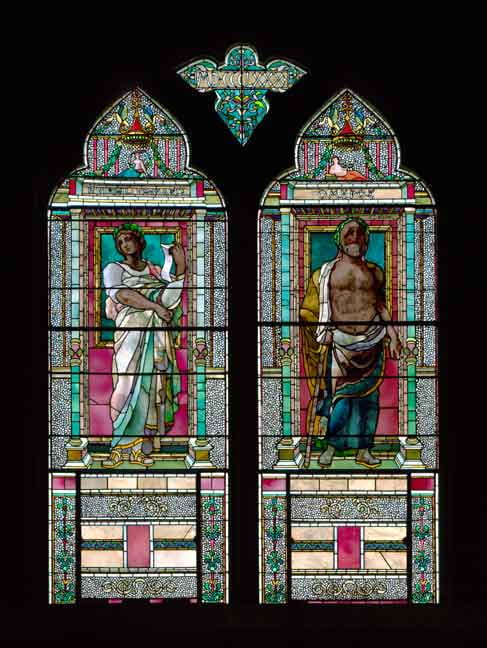
Vergil and Homer
Artist: John La Farge
Manufacturer: John La Farge
Date: 1883
Type: Plated opalescent
Funded by: Class of 1880
The class of 1880, with no dead in the Civil War, shifted the emphasis from a memorial theme to one which would symbolize education and culture. In the left half stands a youthful Vergil wearing a long dark tunic, over which a white robe is draped over his left shoulder and brought around over his right shoulder and arm. His left arm is bent up to support the robe and holds a narrow sheet of paper falling into the bend of his arm. In the right half stands an elderly Homer wearing a cloak of light gold color that is draped over his right shoulder and arm. Gathered around his waist and falling to his ankles is a dark blue robe.
Photographed by: Stephen Sylvester and Yosi A.R-Pozeilov
Digital Imaging and Photography Group Harvard College Libraries
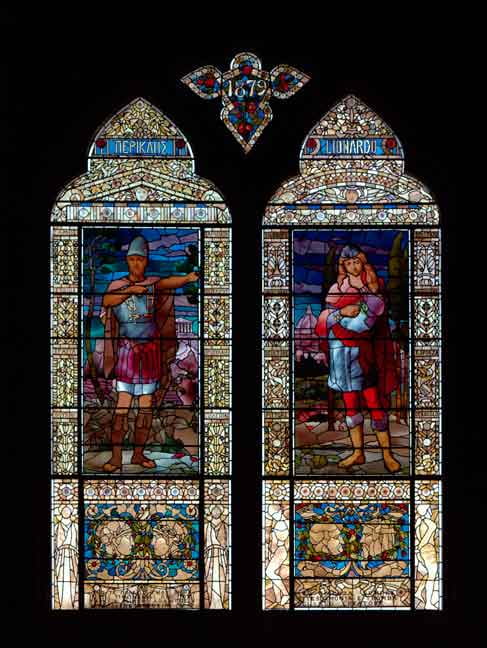
Pericles and Leonardo
Artist: Frederic Crowninshield
Manufacturer: Frederic Crowninshield
Date: 1882
Type: Plated opalescent
Funded by: Class of 1879
In the left half stands Pericles, facing front. He wears a Corinthian helmet and a breastplate, both of which are steel gray. The breastplate has two red leather straps hanging down and the tunic beneath is blue-gray. He also wears a short red cloak. The artist chose to represent Pericles unnarmed, swordless and greaveless. Greek inscriptions commemorate the military achievements of Pericles.
On the right half of the window is Leonardo, depicted as a pensive young man. He wears a tight-fitting blue-gray cap, a red scarf, a steel gray jerkin with a striped belt, and brown leather boots turned down below the knees. He holds a small snake in his right hand, representing Leonardo’s interest in reptiles and symbolizing a certain mysteriousness that pervades his character. Latin inscriptions describe Leonardo as Filosofo / Ingegnere / Scultore / Pittore = Philosopher, Engineer, Sculptor, and Painter.
Photographed by: Stephen Sylvester and Yosi A.R-Pozeilov
Digital Imaging and Photography Group Harvard College Libraries
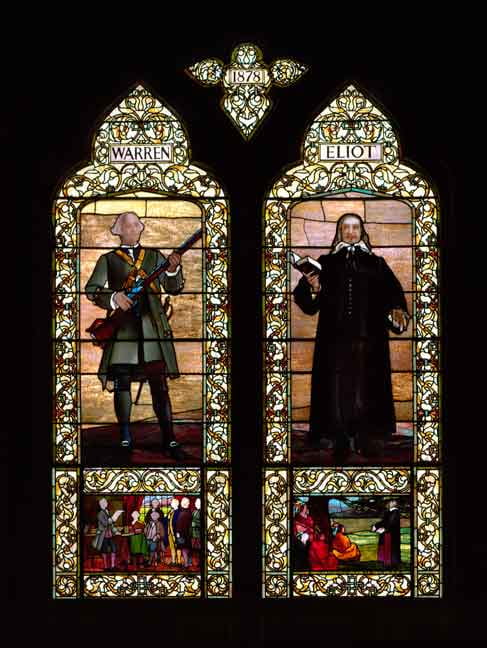
Gen. Joseph Warren and Rev. John Eliot
Artist: Francis Millet
Manufacturer: Tiffany Studios
Date: 1889
Type: Plated opalescent
Funded by: Class of 1878
This window was from one of the six post-war classes whose windows are not memorials but represent themes related to education. In the left panel stands General Joseph Warren, who had drawn up a report for the Boston Committee of Safety entitled “A State of the Rights of the Colonies.” He was later appointed head of a delegation from Boston to a meeting, instigated by him, of a Suffolk County Commission. The purpose of the meeting was to organize resistance to the British Regulatory Acts. Warren drafted the report of the Commission, which came to be known as the “Suffolk Resolves.” The Resolves protested the arbitrary actions of the British government, urged that the colonies unite in opposition to these, and stated that the government of Massachusetts would no longer be the government appointed by the Crown and his Council, but the Provincial Congress of Massachusetts and the Continental Congress. He stands holding a paper in his right hand and rests his left on a table laden with books. In the right panel stands the Reverend John Eliot (1604-1690) who found a Congregational Church in Roxbury over which he presided for nearly sixty years. He was one of a committee of three clergymen who prepared for the Colony a new metrical version of the Psalms which, published in 1640, is commonly called the Bay Psalm Book.
Photographed by: Stephen Sylvester and Yosi A.R-Pozeilov
Digital Imaging and Photography Group Harvard College Libraries
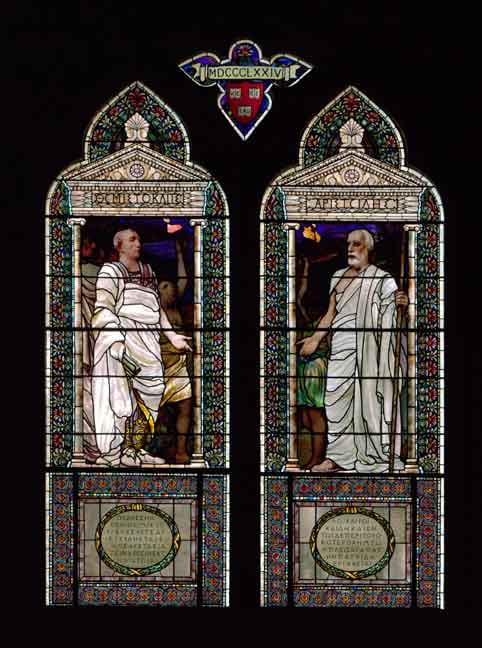
Reconciliation of Themistocles and Aristeides
Artist: Edward Simmons
Manufacturer: Tiffany Studios
Date: 1892
Type: Plated opalescent
Funded by: Class of 1874
In sponsoring this window, the class committee stated , “The subject selected for the window was the reconciliation of Themistocles and Aristeides, the night before the battle of Salamis, and the idea intended to be embodied is that of reconciliation. This was selected both because of the paramount importance of the reconciliation of the North and the South at the close of the War, and because the time of the graduation of the class made this subject an appropriate one. When it is remembered that our class numbers among its members men who proved their devotion to the respective causes of the North and the South by service in the field, the appropriateness of the subject becomes still more striking.”
In the left half stands Themistocles with his body wrapped in a full white robe. His right arm hangs down under the robe and his right hand holds a rolled scroll. His left arm and hand is slightly outstretched towards Aristeides in the other half. In the right half stands Aristeides wearing a heavy white robe. His left arm is bent forward at the elbow and his left hand grasps a tall staff which reaches the ground near the viewer’s right edge of his robe and extends out of the frame in the upper right corner. His right arm and hand are stretched out in greeting towards Themistocles.
Photographed by: Stephen Sylvester and Yosi A.R-Pozeilov
Digital Imaging and Photography Group Harvard College Libraries
Sanders Theatre

Athena Decorating Funerary Column
Artist: John La Farge
Manufacturer: John La Farge
Date: 1899
Type: Plated opalescent
Funded by: Mary S. Felton
Mary S. Felton provided funds for a window in memory of her father, Cornelius Conway Felton, Professor of Greek at Harvard from 1832-1860, and President of Harvard from 1860-1862. On the left half of the window is an ivory column, the bottom half smooth and the upper half fluted. It is topped by an Ionic capital, just below which is tied a long strip of blue cloth. This must represent what the Greeks called a tainia, a strip of cloth used as a mark of honor with magical potency to decorate corpses, urns of ashes, and tombs. The column, therefore, is a funerary one. On the right half of the window stands Athena, a symbol of Greek learning for which Felton was distinguished. Athena wears on her breast a gold ornament, and on her head a bronze Greek helmet with a plume, neckpiece, and cheekguards. She has her arms stretched out, with the right arm behind and somewhat above the left, so as to tie the knot of cloth. Inscribed in the lower border of the window are the words “IN MEMORY OF C C FELTON.”
Photographed by: Stephen Sylvester and Yosi A.R-Pozeilov
Digital Imaging and Photography Group Harvard College Libraries
Memorial Hall Transept

Knight, St. Martin and the Beggar, Inscription, Sidney at Zutphen, Scholar.
Artist: Sarah Wyman Whitman
Manufacturer: Sarah Wyman Whitman
Date: 1898
Type: Plated Opalescent
Funded by: Martin Brimmer (Class of 1849)
Given in memory of the “sons of Harvard” who gave their lives in the Civil War and whose names are recorded in the tablets in the transept. The window was designed by the artist “to commemorate the forces which inspired these heroes. Love of the University is, at one end of the five lower panels, by the Scholar; and at the other end, Love of Country, by the Soldier. Above these are four cherubs holding tablets inscribed with the heroic virtues (Amor, Honor, Virtvs, Patientia = Love, Honor, Courage, Patience); and higher still are angelic figures of praise, while the design culminates in a Rose, wherein the ascription of Glory to God is typified in color, with a choir of angels circling round the center.” This circular window or rose at the top consists of a central rose of dark red and blue glass in floral patterns. Sixteen small circles around this show angels playing musical instruments. In the lower corners of the triangular upper portion of the window are two roundels with angels holding ribbons. The ribbons read “NON NOBIS DOMINE NON NOBIS * SED NOMINE TVO GLORIA SIT” = “Not to us, O Lord, not to us, but to thy name may there be glory.” The window also contains the VE-RI-TAS shield of Harvard and a long Latin inscription that translates to, “Greetings whoever art present. Thou seest the names of those men of Harvard who, fervent youths or men of more mature counsel, sought death that the state [or the Republic] might remain whole. Those (institutions or principles) which they, by dying, preserved, do thou cultivate while thou livest so that men among us may be more free, happy, united.”
Photographed by: Steve Rosenthal

The Virtues Window
Artist: Donald MacDonald
Manufacturer: McPherson
Date: 1874
Type: Painted grisaille
This window has four full rosettes, separating the points of the five lancets. Each rosette contains the word “VERITAS” without any backing Harvard shield. In the five lancets are named ten virtues, two in each lancet on bands crossing to divide them into thirds. The lancets read from left to right as follows:
First:
SPES = Hope
PATIENTIA = Patience
Second:
AUCTORITAS = Authority
DISCIPLINA = Discipline
Third:
MAGNANIMITAS = Magnanimity
CONSTATIA = Constancy [the second N in the Latin is omitted]
Fourth:
FORTITUDO = Fortitude
PRUDENTIA = Prudence
Fifth:
PROCLITAS = ? [Perhaps PROBITAS = Probity was intended]
TEMPERANTIA = Temperance
Photographed by Steve Rosenthal
Go to top of page, detailed listing of the Paintings in Memorial Hall, detailed listing of Sculptures in Memorial Hall, or go back to the home page